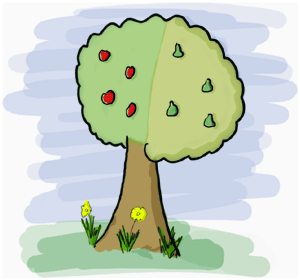Post #73
Apples and pears
16th December 2003, lunch time | Comments (11)

I found out the other day that the old apple tree at the bottom of our garden produces two different kinds of apple. How? Well apparently it’s not one tree, but two stuck together… what you do is:
- Cut off a little branch from Apple Tree ‘A’;
- Make a little cut in Apple Tree ‘B’;
- Stick the little branch in the little cut;
- Slap some goo in and tape it all up;
- Wait a while for the little branch to become a big branch and bud…
And there you have it, a tree that'll produce two kinds of apple. (You can even do it with apples and pears, or practically any kind of similar fruit.)
The process is called ‘grafting’, and can either be used to produce a single tree with two different fruit bearing sections (as in our case), or to combine a super root system from one tree with a super trunk, branch and fruit bearing system of another tree.
I didn’t realise how often, or how easily, this was done:
…an ancient skill with all kinds of modern applications. Almost any fruit tree you buy in the nursery has been grafted with a disease-resistant rootstock to produce a hardier tree … if you can’t decide which apple or peach to graft, you can graft several different varieties onto the same tree.
Most fruit trees and decorative trees you buy from a nursery are grafted. How else could the nursery be sure you were getting a young tree with the characteristics you were promised?
Grafting, like cloning, ensures that the new tree is exactly like the parent tree … the only way to guarantee that any apple tree will propagate true to the parent.
… all MacIntosh trees presently grown have been vegetatively reproduced from the original MacIntosh discovered in 1729 in Dunelda, Ontario. This guarantees that all MacIntosh fruit today is the same as it was in 1729.
There’s a remarkably thorough explanation of the whole process on the University of Minnesota’s Extension Service web site.
I also thought that you could easily grow fruit trees from pips, but apparently that’s not even true:
Gardeners know that planting the seeds of a peach or apple will not culminate in a tree that has the same delicious fruit. Instead, the seeds produce wild progeny, usually with only marginally edible fruit. To get the fruit you crave, grafting is the answer.
I’m amazed I never knew this.
Jump up to the start of the post ↑
Blogmarks
A collection of miscellaneous links that don't merit a main blog posting, but which are interesting none-the-less.
Our enemies are innovative and resourceful, and so are we. They never stop thinking about new ways to harm our country and our people, and neither do we.
— George W Bush (9)- What WordPress is doing to combat comment spam. (1)
- Mobile web tools, from Pukupi. (1)
- Pukupi’s top 10 hints for building interoperable mobile Web sites. (3)
- The photography of E.J. Peiker. (4)
Stuff from the intersection of design, culture and technology.
(3)- Some handy tips for advanced Google use. (35)
- Make your own church signs, or view some real ones. (8)
- Michael Heilemann is doing a great job with his new WordPress theme; Kubrick. (1)
- I’m late to the party, but Dan has a book out. (1)
- What a crazy concept for laying out housing estates. (3)
- In San Francisco, I live here. (Try the zoom feature.) (1)
- Spider-Man reviews crayons. [Via] (3)
- Some beautiful images from photographer Greg Downing. (2)
- Lots of links, from the Link Bunnies. (1)
- Nice “when I was a child” sort of post from Stuart. (1)
- How much does SafariSorter cost? (4)
- Some handy maintenance tips for Mac owners running Panther. (2)
- Alex King launches Use Tasks: a hosted service for Tasks and Tasks Pro™. (2)
- Min Jung, Anil Dash, and I get interviewed for HBO’s Real Sex. (10)
Blog-roll
A selection of blogs I read on a regular basis.
- Hmm, the blog-roll seems to be a little bit broken right now (it may be that the blo.gs service is having problems). I’ve sent myself an email about this problem, and will try to fix it ASAP.